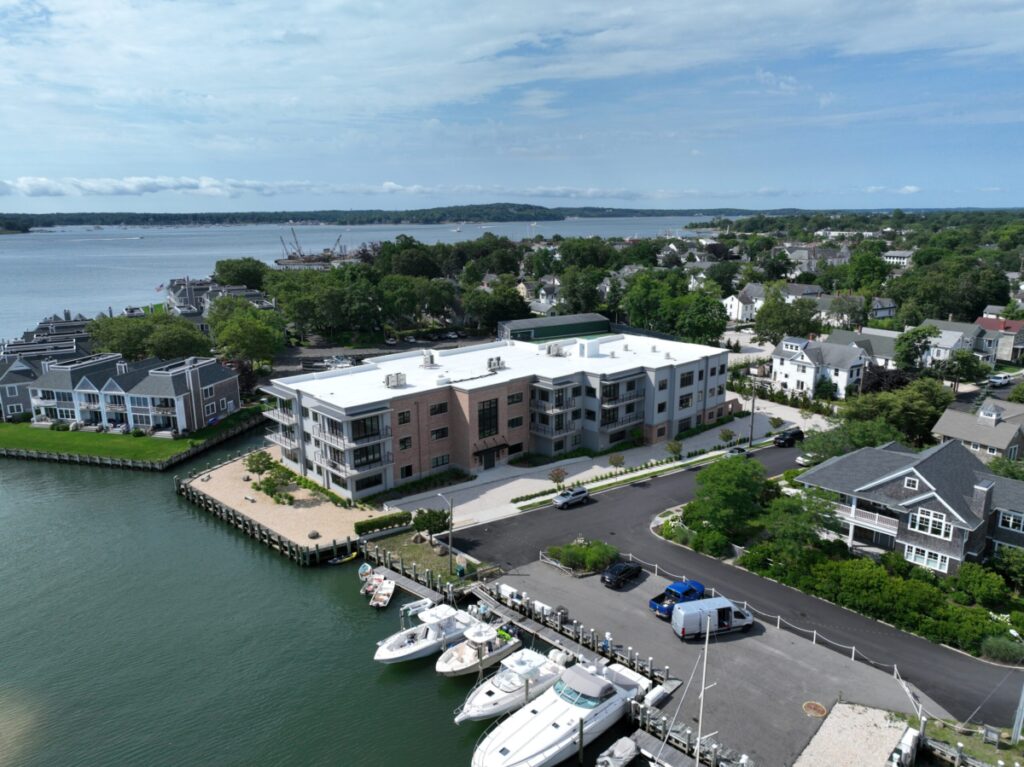

Greenport offers new affordable housing. (Credit: Chris Francescani/Sunset Beach Films)
For the first time in decades, Greenport is rolling out new affordable housing.
Sixteen years later, a plan to build a market-rate apartment complex on Greenport’s prized waterfront sealed the deal for the first five affordable apartments that finally went on sale last month. The June 8 edition of the Suffolk Times carried an ad for job seekers.
The five residential units, which range in size from 600 to 650 square feet, are priced at $175,000 each, but buyers must meet a series of financial and residential criteria to qualify for a unit.
Kristopher Amplo of Forty Forty Five Real Estate LLC, which owns the property, said about 80 applications for affordable housing have been received so far. He said the developer is working closely with the Greenport Housing Authority and village officials and sharing the application with the authority, which will help vet applicants for eligibility.
Mr Amplo said his company was “working closely with the village to select the final selected application”.
He said there would be no lottery.
“This is not a lottery situation.”
He said he was “unable to detail how they were selected, other than to say that we are following the rules set out with the village and the original property developer.”
Mr Amplo also said that while there was no “hard end date” for accepting applications, the application process would have to end soon.
In order to apply, potential buyers must have lived or worked within the village or school district boundaries for at least two years; the unit must be the owner’s primary residence; and the buyer must be a first-time home buyer, own no other residential property and have an annual income of less than $139,480.
Affordable homes cannot be consolidated, and while owners can sell them at market rate after two years, this would trigger a “flip tax” equal to 25 percent of the difference between the original purchase price of $175,000 and the sale price. Tax revenue will be split equally between villages and developers.
The five affordable units have been at the center of controversy over the property’s fate since the first deal was struck to include them in the project in 2007.
Since then, various developers, village officials and Sterling Avenue neighbors have debated the fate of the former 45,000-square-foot shellfish processing plant.
Richard Raskin spent five years battling the Sterling Basin Neighborhood Association before reaching an agreement in 2007 that included affordable housing and many other use and zoning requirements . But the project never got off the ground, and in 2019 his team sold the property to Paul Pawlowski and 123 Sterling Ave. LLC.
Mr. Pawlowski built the complex and spent several years trying to renegotiate the terms of a 2007 agreement so he could move the five affordable units to another location. But that effort failed, and two years later, Mr. Pavlovski sold the property to Forty-Five Real Estate.
With at least four of a dozen market-rate condos still on sale more than a year later, the original planned condo price points have been reduced — in some cases dramatically.
Amplow said a “small number” of market-rate apartments are currently under contract.
Unlike some proposals for 123 Sterling Avenue over the years, there is no commercial component in the current operating plan.
Greenport Mayor Kevin Stuessi said he was pleased to see the five new apartments hit the market, but he would have preferred to see them hit the market last spring, when market-rate apartments were first advertised for sale.
“There’s no doubt that it’s a great thing to see these units come to market,” he said.
“One of the first things I did when I took office” was push the process forward, Stuci said, calling for a meeting between developer and Huntington Councilman Salvatore Ferro and his attorney, the mayor said. Mr. agrees to start marketing affordable housing. Mr Filo declined to comment.
“After reading the agreement, I believe that these restricted units should be sold immediately in May 2022 when they become available at market price,” Mr Stuessi said.
Mr Amplo said only that the timing of bringing new equipment to market was a “commercial decision”.
“The timing of these projects coming to market is exceptional,” former mayor David Kappel, who oversaw negotiations on the original deal in 2007, said this week.
“The challenge with this village, unlike the town, is that there is very little land to build on.”
He said the original agreement was aimed at ensuring affordable housing remained affordable.
“By design, the apartments are relatively small and austere and won’t appeal to most people in the market. That’s using a market approach rather than a regulatory approach.”
Both the former and current mayors say the village hasn’t provided new affordable housing in decades.





